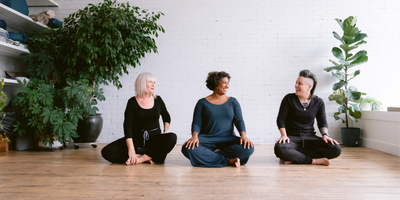Can Meditation Help Anxiety?
In our hyper-connected, fast-paced world, anxiety often feels like an uninvited guest that just won’t leave. If you’re exploring ways to manage your stress, you might be wondering if meditation could help with anxiety. The short answer is yes! Let’s delve into how this ancient practice can benefit many people while also acknowledging that it might not be the right fit for everyone—and that’s perfectly okay. We’ve also included some mindfulness practices that can support you in managing anxiety.

The Science of Meditation and Its Impact on Anxiety
Research published in The Journal of Clinical Psychiatry found that mindfulness meditation can help reduce symptoms of anxiety by enhancing activity in the brain's prefrontal cortex. This area is responsible for higher-order functions such as decision-making and emotional regulation, which can help individuals better manage their anxiety and stress levels.
By focusing on the present moment, meditation helps interrupt the cycle of worry and stress, which can lower cortisol levels (the stress hormone) and activate the body’s relaxation response.
Starting with Meditation
Here are some suggestions on how to start a meditation practice:
Create a Comfortable Space ~ Designate a quiet area where you can comfortably unwind and focus. Use a meditation cushion, bolster, chair or other props to provide comfort. The goal is to find a position where you feel relaxed and can maintain an open posture. Options to enhance the space with calming elements like soft lighting, a soothing blanket, plants, candles, essential oils. etc.

Start Small ~ As you begin your meditation journey, use your breath as an anchor. Whenever your mind starts to wander, gently bring your focus back to the sensation of your breath—feel the air entering and leaving your body. This simple, natural focus point helps center your thoughts and maintain a calm, grounded state, making it easier to stay present and engaged in your practice.
Explore Different Techniques ~ Meditation encompasses a wide range of techniques, each offering unique benefits. For instance, mindfulness meditation helps you focus on the present moment, while loving-kindness meditation fosters compassion and positive emotions towards yourself and others. Body scan meditation involves paying close attention to physical sensations, promoting deep relaxation and awareness.
If you’re new to meditation, guided meditations can be especially helpful. Many apps and online platforms offer guided sessions tailored to various needs, such as reducing stress, improving sleep, enhancing concentration, etc.

Mindfulness Practices Beyond Meditation
While meditation can be incredibly effective for many people, it’s important to acknowledge that it might not be the right fit for everyone. Some individuals may find discomfort sitting still or struggle with intrusive thoughts during meditation, don’t be discouraged. There are other ways to cultivate mindfulness and manage anxiety.
Mindful Breathing ~ This practice involves focusing on your breath. You can do this anywhere—while sitting at your desk, walking, or even standing in line. Simply pay attention to your breath as it enters and exits your body. This can help ground you in the present moment and reduce feelings of anxiety.
Mindful Walking ~ If sitting still is challenging, try walking meditation. As you walk, focus on the sensation of your feet touching the ground, the movement of your legs, and your surroundings. This practice helps connect your body and mind, offering a dynamic alternative to traditional meditation.
Body Scan ~ This technique involves mentally scanning your body from head to toe, noticing any areas of tension or discomfort. It’s a way to connect with physical sensations and release stress. You can do a body scan lying down or sitting comfortably.
Mindful Eating ~ Turn meals into a mindful practice by focusing on the taste, texture, and aroma of your food. Eating slowly and attentively can enhance your relationship with food and help you stay present.
Journaling ~ Writing down your thoughts and feelings can be a therapeutic way to process emotions. Journaling allows you to reflect on your experiences and identify patterns or triggers related to your anxiety.
Creative Outlets ~ Engaging in creative activities like drawing, painting, or playing a musical instrument can be a form of mindfulness. These activities help you focus on the present moment and express yourself in a non-verbal way.

Be Patient and Compassionate with Yourself
Finding the right approach to managing anxiety can take time. Whether you’re meditating or exploring other mindfulness practices, remember to be patient and compassionate with yourself. It’s about discovering what resonates with you and making small, consistent efforts to incorporate those practices into your daily life.
Meditation and mindfulness offer valuable tools for managing anxiety, but they’re not the only options. By being open to different methods and finding what works best for you, you’re taking meaningful steps toward a more balanced and peaceful life.

Invitation to let go of any expectations of what your journey should look or feel like.
Always return to self compassion and resource the nourishment within your breath.
With the right props to bring comfort to your body, you can more easily access the inner peace that meditation offers.
~ Taking a deep cycle of breaths with you here. We're in this together.
With Kindness + Warmth,
Lor




